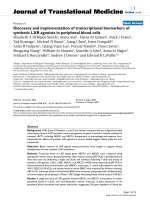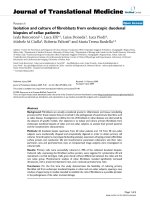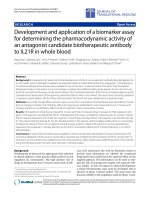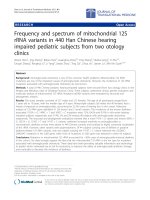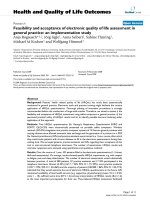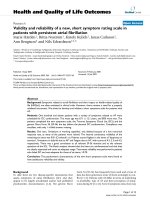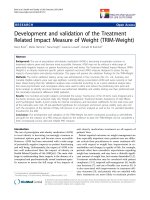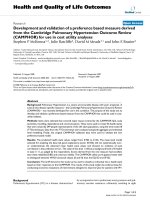Báo cáo hóa học: " Validity and reliability of the Spanish version of the DN4 (Douleur Neuropathique 4 questions) questionnaire for differential diagnosis of pain syndromes associated to a neuropathic or somatic component" docx
Bạn đang xem bản rút gọn của tài liệu. Xem và tải ngay bản đầy đủ của tài liệu tại đây (293.95 KB, 10 trang )
BioMed Central
Page 1 of 10
(page number not for citation purposes)
Health and Quality of Life Outcomes
Open Access
Research
Validity and reliability of the Spanish version of the DN4 (Douleur
Neuropathique 4 questions) questionnaire for differential diagnosis of
pain syndromes associated to a neuropathic or somatic component
Concepcion Perez*
1
, Rafael Galvez
2
, Silvia Huelbes
3
, Joaquin Insausti
4
,
Didier Bouhassira
5,6
, Silvia Diaz
7
and Javier Rejas
8
Address:
1
Unit of Pain, Hospital de la Princesa, Madrid, Spain,
2
Unit of Pain and Palliative Care, Hospital Universitario Virgen de las Nieves,
Granada, Spain,
3
Neurological Research Unit, Hospital Nacional de Parapléjicos, Toledo, Spain,
4
Unit of Pain, Hospital Severo Ochoa, Leganés,
Spain,
5
INSERM U-792, Hôpital Ambroise Paré, Boulogne-Billancourt, F-92100 France,
6
Université Versailles-Saint-Quentin, Versailles F-78035,
France,
7
Department of Health Outcomes Research, Artac Bioestudios, Madrid, Spain and
8
Department of Health Outcomes Research, Medical
Unit, Pfizer Spain, Alcobendas, Spain
Email: Concepcion Perez* - ; Rafael Galvez - ; Silvia Huelbes - ;
Joaquin Insausti - ; Didier Bouhassira - ; Silvia Diaz - ;
Javier Rejas -
* Corresponding author
Abstract
Background: This study assesses the validity and reliability of the Spanish version of DN4
questionnaire as a tool for differential diagnosis of pain syndromes associated to a neuropathic (NP)
or somatic component (non-neuropathic pain, NNP).
Methods: A study was conducted consisting of two phases: cultural adaptation into the Spanish
language by means of conceptual equivalence, including forward and backward translations in
duplicate and cognitive debriefing, and testing of psychometric properties in patients with NP
(peripheral, central and mixed) and NNP. The analysis of psychometric properties included
reliability (internal consistency, inter-rater agreement and test-retest reliability) and validity (ROC
curve analysis, agreement with the reference diagnosis and determination of sensitivity, specificity,
and positive and negative predictive values in different subsamples according to type of NP).
Results: A sample of 164 subjects (99 women, 60.4%; age: 60.4 ± 16.0 years), 94 (57.3%) with NP
(36 with peripheral, 32 with central, and 26 with mixed pain) and 70 with NNP was enrolled. The
questionnaire was reliable [Cronbach's alpha coefficient: 0.71, inter-rater agreement coefficient:
0.80 (0.71–0.89), and test-retest intra-class correlation coefficient: 0.95 (0.92–0.97)] and valid for
a cut-off value ≥ 4 points, which was the best value to discriminate between NP and NNP subjects.
Discussion: This study, representing the first validation of the DN4 questionnaire into another
language different than the original, not only supported its high discriminatory value for
identification of neuropathic pain, but also provided supplemental psychometric validation (i.e. test-
retest reliability, influence of educational level and pain intensity) and showed its validity in mixed
pain syndromes.
Published: 4 December 2007
Health and Quality of Life Outcomes 2007, 5:66 doi:10.1186/1477-7525-5-66
Received: 17 September 2007
Accepted: 4 December 2007
This article is available from: />© 2007 Perez et al; licensee BioMed Central Ltd.
This is an Open Access article distributed under the terms of the Creative Commons Attribution License ( />),
which permits unrestricted use, distribution, and reproduction in any medium, provided the original work is properly cited.
Health and Quality of Life Outcomes 2007, 5:66 />Page 2 of 10
(page number not for citation purposes)
Background
Appropriate therapeutic management of pain requires an
accurate diagnosis, distinguishing its cause and origin.
According to the International Association for the Study
of Pain (IASP), neuropathic pain (NP) is defined as a pain
initiated or caused by a primary lesion (or dysfunction) of
the nervous system, and comprises a very large group of
neurological conditions including diabetic and other sen-
sory polyneuropathies, trigeminal neuralgia, post-her-
petic neuralgia, stroke, spinal cord injury, and multiple
sclerosis, as well as common conditions such as lumbar or
cervical radiculopathies, traumatic or postsurgical nerve
injuries, etc [1-4]. Virtually any condition damaging the
nervous tissues or causing neuronal dysfunction may
cause NP [5], suggesting that NP prevalence is high in the
general population. Recent data suggest that NP might
affect up to 5%–8% of the general population [6-10].
Due to the lack of validated or consensual diagnostic cri-
teria, diagnosis of NP has traditionally been based on
identification of the neurological lesion through the med-
ical history, neurological examination, and appropriate
electrophysiological or imaging investigations [11,12]. A
series of recent studies [13-18] confirmed that chronic
pain associated to a nerve lesion has specific clinical char-
acteristics and showed that the combinations of selected
symptoms and signs have a very high discriminant value
for identification of this category of pain. This was the
basis for the development and validation of screening
tools in the form of simple questionnaires that could be
helpful both in daily practice and clinical research. Inter-
estingly, although they were developed in parallel in dif-
ferent countries and languages (English, German,
French), most items (i.e. pain descriptors) included in
these clinical tools are similar [19]. Thus, despite the spe-
cificities associated to the description of chronic pain in
different cultures, the symptom-based approach for diag-
nosis of neuropathic pain appears to have transcultural
validity.
In order to test this hypothesis, this study analyzed the
psychometric properties of the DN4 questionnaire trans-
lated into Spanish. The DN4 questionnaire was originally
developed and validated in French [15]. It is a clinician-
administered questionnaire consisting of 10 items. Seven
items related to pain quality (i.e. sensory and pain
descriptors) are based on an interview with the patient,
and 3 items based on the clinical examination are related
to the presence or absence of touch or pinprick hypoesthe-
sia and tactile allodynia. The DN4 questionnaire has very
good sensitivity (83%) and specificity (90%) for identifi-
cation of chronic pain associated to a lesion in the nerv-
ous system (either peripheral or central).
Thus, the aim of this study was not only the translation
and cultural adaptation of the DN4 questionnaire into
Spanish, but to provide also a supplemental psychometric
validation of the questionnaire. In particular, in addition
to the general diagnostic properties of our translated ques-
tionnaire (i.e. sensitivity and specificity), its test-retest reli-
ability was verified, and the influence of various factors,
such as pain intensity and educational level, on the DN4
results was analyzed. The DN4 was also administered to a
group of patients with a combination of neuropathic and
non-neuropathic pain to support its validity in mixed
pain syndromes.
Methods
The DN4 questionnaire [15] consists of a total of 10 items
grouped in 4 sections [Additional file 1]. The first seven
items are related to the quality of pain (burning, painful
cold, electric shocks) and its association to abnormal sen-
sations (tingling, pins and needles, numbness, itching).
The other 3 items are related to neurological examination
in the painful area (touch hypoesthesia, pinprick
hypoesthesia, tactile allodynia). A score of 1 is given to
each positive item and a score of 0 to each negative item.
The total score is calculated as the sum of all 10 items, and
the cut-off value for the diagnosis of neuropathic pain is a
total score of 4/10. All questions are related to pain which
is the claim for current medical consultation.
Translation of the questionnaire
The adaptation into Spanish of the DN4 questionnaire
and the subsequent assessment of its psychometric prop-
erties (i.e. reliability and validity) have been performed
following the traditional recommendations for adapta-
tion and validity of health questionnaires and diagnostic
tests [20-25]. In the preparation phase, an expert panel
was selected, the original questionnaire was translated,
the sample was defined, and the study documentation
was prepared. The adaptation procedure was monitored
by a five-expert panel including three specialists in pain
management, an expert in methodology, and an expert in
clinical research. These experts reviewed the translation
and monitored the adaptation process. As the original ver-
sion of the questionnaire was well defined and structured,
the expert panel did not consider it necessary to redefine
its sections or reformulate the original questions. No cul-
tural bias that could be equivocal or non-translatable was
detected in the original instrument. Questionnaire trans-
lation was commissioned to two independent profes-
sional translators (philologists, Spanish natives) to have
two parallel translations. The expert panel pooled both
translations into a single version that was tested in a sam-
ple of 12 patients [other than those included in the vali-
dation sample; 7 (57%) males, mean age 64.5 ± 15.3 years
(± standard deviation)] to assess initial feasibility and
potential understanding problems. The final version was
Health and Quality of Life Outcomes 2007, 5:66 />Page 3 of 10
(page number not for citation purposes)
back-translated into French by two other professional
translators (different from the first two translators, and
French natives) and submitted to the original author (Dr.
D Bouhassira), who proposed a change in the translation
of one of the descriptors in the pain scale to certify agree-
ment with the original instrument.
Patients
Patients of both sexes with chronic pain for more than 3
months aged 18 years or over, with an adequate cultural
level to understand health questionnaires administered in
Spanish were included in this study. Chronic pain could
be of a neuropathic, non-neuropathic, or mixed (i.e. both
neuropathic and non-neuropathic components) origin.
Pain was classified based on the medical history, physical
examination, and any procedures (laboratory tests, elec-
trophysiology, imaging, etc.) considered appropriate by
the clinicians to establish the diagnosis of the type of pain.
All patients gave their written informed consent before
entering the study. Tables 1 and 2 show the main sociode-
mographic data and clinical conditions responsible for
pain in the study sample.
Study design
In addition to the DN4 questionnaire, average daily pain
intensity was measured using a 100 mm visual analogue
scale (VAS), and the short-form McGill Pain Question-
naire (SF-MPQ) [26] was used to assess the sensory and
affective components of pain. The SF-MPQ includes 15
items related to the presence and severity (assessed with a
4-point Likert scale) of pain descriptors associated to the
affective (4 items) or sensory (11 items) dimensions of
chronic pain.
All investigators were pain experts. At each participating
center, the main investigator collected the sociodemo-
graphic and clinical data required for patient characteriza-
tion and was required to classify patients into two broad
diagnostic categories corresponding to NP and NNP, and
to further subcategorize NP into peripheral, central or
mixed pain. The diagnosis of the principal investigator
was considered as the reference (gold standard) diagnosis.
Patients were then separately seen within 2 days by two
other investigators (raters A and B) blinded to the diagno-
sis proposed by the principal investigator, who adminis-
tered the DN4 and SF-McGill questionnaires.
This study was conducted according with usual standard
of care in each participant centre, and it did not involve
any drug or therapeutic management. Nevertheless, the
study design was approved by the IRB of the Universidad
Autónoma de Madrid and was conducted in compliance
with the Helsinki Declaration for research in humans.
Psychometric measurements and statistical analysis
Reliability
The internal consistency of the Spanish version of the
DN4 questionnaire was separately established for raters A
and B by calculating Cronbach's α coefficient that assesses
the contribution of each item to the precision of measure-
Table 1: Demographic characteristics of study patients, overall and by the main subgroups with (NP) and without (NNP) associated
neuropathic component.
Variable Total NP NNP
N 158 99 (62.7%) 59 (37.3%)
Sex, females; n (%) 93 (58.9%) 46 (47%)
†
47 (80%)
Race (Caucasian); n (%) 149 (95.5%) 93 (94%) 56 (98%)
Age (years) 60.1 (15.9) 57.2 (15.2)
†
64.9 (16.1)
BMI (kg/m
2
) 27.3 (4.6) 27.3 (4.1) 27.2 (5.4)
Drug therapy;
n (%): 145 (91.8%) 89 (90%) 56 (95%)
no. of drugs:
a
2.0 (1.0 – 3.0) 2.0 (1.0 – 3.0) 2.0 (1.0 – 3.0)
Educational level; n (%)
†
No studies: 39 (25.0%) 19 (19%) 20 (35%)
Primary school: 69 (44.2%) 45 (46%) 24 (41%)
High school: 14 (9.0%) 12 (12%) 2 (3%)
Vocational training: 16 (10.3%) 14 (14%) 2 (3%)
Graduate studies: 18 (11.5%) 8 (8%) 10 (17%)
SF-MPQ scoring;
Sensory dimension (0 – 33): 12.4 (6.4) 13.1 (6.0) 11.3 (6.8)
Affective dimension (0 – 12): 4.9 (3.6) 4.8 (3.6) 5.2 (3.6)
Total score (0 – 45): 17.4 (8.3) 17.9 (8.1) 16.5 (8.8)
Pain in the previous week (VAS; 0 – 100): 65.4 (20.7) 65.6 (22.2) 65.0 (18.2)
Values are given as mean (standard deviation) or frequency (%) based on the number of valuable cases (information available). BMI = Body Mass
Index, SF-MPQ = Short Form McGill Pain Questionnaire.
a
Median (1st – 3rd quartile),
†
p < 0.05 vs. NNP group.
Health and Quality of Life Outcomes 2007, 5:66 />Page 4 of 10
(page number not for citation purposes)
ments by the instrument. Cronbach's α coefficient was
assessed in the complete questionnaire and after remov-
ing each item from it to assess the independent contribu-
tion of each item to the measurement error in the
instrument.
Inter-rater reliability was assessed by the agreement of the
results obtained by raters A and B for each item and the
total score of the DN4 questionnaire. Agreement was
determined by calculating the Cohen's kappa coefficient.
Inter-rater agreement was also determined by calculating
the intra-class correlation coefficient of the total scores
assigned by each pair of raters to the same subject, and the
answers to each individual item, using a two-factor model
and mixed effects.
In a subject sub-sample (n = 68), the test-retest reliability
of the questionnaire was assessed by a third administra-
tion, after at least 48 hours, of the DN4 scale by rater B.
Stability of the questionnaire was analyzed by measuring
the intra-class correlation coefficient between the scores of
clinicians completing test and retest and using Cohen's
kappa coefficient of agreement for the total retest sample
and in subgroups by type of pain.
Validity
A ROC (receiver operating characteristic) curve analysis
was performed to determine the cut-off value of the ques-
tionnaire score providing the best values of sensitivity and
specificity for NP diagnosis and determination of
Youden's index for the total patient sample included in
the study. This was repeated in two sub-samples excluding
either patients with mixed pain only or patients with
mixed and subjects with central NP (just to test the instru-
ment in patients with peripheral NP only). For each cut-
off value of the scale score, in addition to sensitivity and
specificity and Youden's index, the positive (PPV) and
negative predictive value (NPV), the kappa coefficient of
agreement with the diagnosis according to the standard
criterion or reference diagnosis, and the area under the
curve (AUC) calculated by the trapezoid method and its
significance level were estimated. The 95% confidence
intervals (95% CI) of the estimators of the cut-off point
selected as optimum were calculated. Validity indicators
(sensitivity, specificity, PPV, and NPV) were recalculated
individually for the presence of each descriptor symptom
of the DN4 questionnaire. The Youden's index was calcu-
lated by the equation: sensitivity + specificity - 1 [27].
Descriptive statistics were prepared for the variables tested
in this study to assess central positition, dispersion, and
distribution of variables tested by the Kolmogorov- Smir-
nov test. A Student's t test for independent groups or a
Mann-Whitney's U test was used in the case of a non-nor-
mal distribution to compare continuous or ordinal varia-
bles respectively between patients with NP and NNP. All
statistical tests were two-tailed, and an α error of < 0.05
was accepted as statistically significant. Data were ana-
lyzed using SPSS version 12.0 statistical software.
Results
Sample description
The study was conducted from June to November 2005.
Table 1 summarizes the clinical and sociodemographic
characteristics of the 158 patients, 99 with NP and 59 with
NNP, included in the study, and Table 2 details pain eti-
ology. NP was peripheral in 25 (25%) patients, central in
32 (32%), and mixed in 42 patients (42%). The propor-
tion of women and the mean age were significantly higher
in the NNP group, but the two groups were homogenous
in terms of educational level, pain intensity and analgesic
treatment (Table 1). The SF-MPQ total score and sub-
scores by dimension were not statistically significant
between patients with or without NP (Table 1).
Analysis of psychometric properties of the Spanish version
of the DN4 questionnaire
Internal consistency, inter-rater agreement and test-retest reliability
Table 3 summarizes the values of the indicators related to
reliability of the Spanish version of the DN4 question-
naire. Our data support the reliability of the instrument
both in terms of internal consistency (Cronbach's α of
Table 2: Distribution of the most common etiological causes of neuropathic pain (peripheral and central), mixed pain and non-
neuropathic pain in the study patients.
Neuropathic Pain (n = 57) Mixed Pain (n = 42) Non Neuropathic Pain (n = 59)
Peripheral 25 (44%) Radiculopathys 26 (62%) Osteoarthritis 50 (85%)
Polyneuropathy 6 (24%) Entrapment syndrome 5 (12%) Spondylolisthesis 4 (7%)
Neuralgia* 16 (64%) Atypical facial pain 3 (7%) Mechanical low back pain 5 (8%)
Phantom member syndrome 3 (12%) Others** 8 (19%)
Central 32 (56%)
Spinal cord injury 26 (81%)
Post-stroke 4 (13%)
Multiple sclerosis 2 (6%)
Includes trigeminal (n = 5) and post-herpetic (n = 11) neuralgia. ** Includes complex regional pain syndrome, parestethic meralgia and cancer.
Health and Quality of Life Outcomes 2007, 5:66 />Page 5 of 10
(page number not for citation purposes)
approximately 0.7 in both observers) and inter-rater relia-
bility (Cohen's kappa coefficients ranging from 0.68 and
0.79) or questionnaire stability (intra-class correlation
coefficients ranging from 0.92 and 0.95). Cronbach's α
coefficients did not improve when each scale item was
successively removed (values ranging from 0.60 and
0.71), which justifies the contribution of each item to
measure the concept measured by the questionnaire
(Table 3).
Inter-rater reliability, which is essential for an instrument
that contains a semi-structured interview subject to inter-
viewer interpretation, was good to very good. The total
scores in each diagnostic group did not show statistically
significant differences, and the intra-class correlation coef-
ficient values ranged from 0.84 and 0.93 (Table 3). Calcu-
lation of the kappa coefficients supported the inter-rater
agreement regarding diagnostic classification. In addition,
retest results confirmed that the DN4 questionnaire has
good test-retest stability, with intra-class correlation coef-
ficients ranging from 0.92 and 0.95.
Validity
Table 4 gives the results of scale validity as a diagnostic
method for NP, comparing its properties first in the total
sample of NP patients, and then after successively remov-
ing patients with mixed pain and with central NP. In all
cases, ROC curve analysis identified a score of 4 as the best
cut-off value discriminating between NP and NNP (values
of the area under the curve ranging from 0.85 to 0.87, p <
0.001 in all cases, and the highest values of the Youden's
index). This cut-off point showed, in all cases compared,
values of 70% or higher (except for PPV in the case of
peripheral NP) in indicators of sensitivity, specificity, pos-
itive predictive value (PPV), and negative predictive value
(NPP), which anticipates a low percentage of both false
positive and false negative results when the questionnaire
is used.
The graphs plotting the cut-off point optimizing the sen-
sitivity and specificity values consistently show a cut-off
point ≥ 4 points as the most appropriate value for discrim-
inating between NP and NNP in both the total sample
and after removing patients with mixed pain and central
NP (Figures 1, 2 and 3 respectively).
The indicators of the validity of the DN4 questionnaire to
differentiate NP from NNP were good in all cases, regard-
less of whether the analysis included all patients with NP
and NNP or patients with mixed pain or central NP were
removed. The improvement seen in sensitivity values
when patients who could introduce classification errors
were removed was moderate, though both positive and
negative predictive values showed more marked changes,
improving as expected as patients who could potentially
add errors (case of negative predictive value) were
removed, and worsening when such patients were
included (case of the positive predictive value, Table 4).
Validity in subgroups according to pain severity and educational level
Table 5 shows the validity properties of the DN4 question-
naire in patient subgroups depending on mean pain
Table 3: Internal consistency, inter-rater agreement, and test-retest reliability of the Spanish version of the DN4 questionnaire.
Inter-rater agreement
Rater A Rater B ICC (95% CI) Kappa
§
(95% CI)
Total sample (n = 158) 4.1 (2.3)
†
4.2 (2.5) 0.926 (0.899–0.946)
‡
0.79 (0.69–0.89)
NP (n = 99) 5.0 (2.2)
†
5.1 (2.4) 0.925 (0.888–0.949)
‡
0.68 (0.49–0.86)
NNP (n = 59) 2.6 (1.8)
†
2.7 (2.0) 0.840 (0.730–0.905)
‡
0.72 (0.50–0.93)
Internal consistency (Cronbach's α
1
)
0.65 0.71
Test-retest reliability
Test Re-test ICC (95% CI) Kappa
§
(95% CI)
Retest sample (n = 67) 3.7 (2.5)
†
3.6 (2.6) 0.949 (0.916–0.969)
‡
0.79 (0.64–0.94)
NP (n = 37) 4.7 (2.4)
†
4.4 (2.5) 0.952 (0.904–0.976)
‡
0.75 (0.53–0.98)
NNP (n = 30) 2.5 (2.0)
†
2.7 (2.4) 0.923 (0.840–0.963)
‡
0.78 (0.56–1.00)
NP = Neuropathic Pain, NNP = Non-Neuropathic Pain (somatic), ICC = Intra-class Correlation Coefficient, 95% CI = 95% confidence interval,
1
Coefficients for the entire questionnaire (10 items)
†
p > 0.05 between raters (Friedman's paired test),
‡
p < 0.001 (p value for intra-class
correlation coefficient),
§
Kappa using a cut-off value > 4 pts.
Health and Quality of Life Outcomes 2007, 5:66 />Page 6 of 10
(page number not for citation purposes)
severity in the week prior to questionnaire administration
and depending on the educational level of patients. Ques-
tionnaire performance was not significantly influenced by
the educational level, but was significantly decreased in
patients with mild pain.
Discussion
This study represents the first validation of the DN4 ques-
tionnaire, originally validated into French, into another
language. Overall, the high discriminant value of the
Spanish version of the DN4 questionnaire for identifica-
tion of neuropathic pain was confirmed. In addition, our
Cut-off point in the DN4 questionnaire optimizing the sensitivity and specificity values for discriminating between neuropathic pain and non-neuropathic pain in the overall sampleFigure 1
Cut-off point in the DN4 questionnaire optimizing the sensitivity and specificity values for discriminating between neuropathic
pain and non-neuropathic pain in the overall sample.
A score > 4 points in the sum of the 10 items of the DN4 questionnaire resulted in the
best discriminant cut-off point for the overall sample.
0%
10%
20%
30%
40%
50%
60%
70%
80%
90%
100%
12345678 910
Cutoff point
Sensitivity
0%
10%
20%
30%
40%
50%
60%
70%
80%
90%
100%
Specificity
>
Table 4: Comparison of the psychometric properties of validity for differential diagnosis of neuropathic pain vs non-neuropathic pain
for a cut-off value ≥ 4 points in the Spanish version of the DN4 questionnaire, in the overall sample and in patients with pure
neuropathic pain (excluding those with mixed pain) and with peripheral neuropathic pain (excluding patients with mixed and central
pain).
All patients (n = 158) Mixed pain excluded (n = 116) Mixed and central pain
excluded (n = 84)
Youden index 0.58 0.60 0.60
Sensitivity (%) 79.8% (71%–87%) 81.7% (70%–91%) 82.1% (63%–94%)
Specificity (%) 78.0% (65%–88%) 78.0% (65%–88%) 78.0% (65%–88%)
PPV (%) 85.9% (77%–92%) 79.0% (67%–88%) 63.9% (46%–79%)
NPV (%) 69.7% (57%–80%) 80.7% (68%–90%) 90.2% (79%–97%)
AUC 0.85 (0.79–0.91)
†
0.87 (0.80–0.93)
†
0.87 (0.78–0.96)
†
% of agreement 79.1% (72%–85%)
§
79.8% (72%–87%)
§
79.3% (69%–87%)
§
Kappa's Agreement 0.56 (0.43–0.70)
‡
0.60 (0.45–0.75)
‡
0.56 (0.39–0.74)
‡
Youden index = Sensitivity + Specificity – 1, 95% confidence interval in brackets, PPV = Positive Predictive Value, NPV = Negative Predictive Value,
AUC = Area under the curve (ROC curve analysis).
†
p < 0.001 (p value in ROC curve analysis),
§
p > 0.05 between reference diagnosis and DN4
classification for a cut off value ≥ 4 pts (McNemar's test),
‡
p < 0.001 (p value for Cohen's kappa of agreement between reference diagnosis and
DN4 classification for a cut off value ≥ 4 pts).
Health and Quality of Life Outcomes 2007, 5:66 />Page 7 of 10
(page number not for citation purposes)
study provided new information about the test-retest reli-
ability of the questionnaire, the influence of educational
level and pain intensity on its performance, and its valid-
ity in mixed pain syndromes.
Identification of neuropathic components is crucial for
characterization of chronic pain patients and to adapt the
therapeutic approach, given the differential response of
neuropathic pain to analgesic treatment [7,28,29]. There-
fore, a better identification of neuropathic pain should
improve the therapeutic outcome. Several diagnostic and
screening tools have been developed and validated over
the past few years for this purpose [19]. All these screen-
ing/diagnostic tools make use of similar descriptors to dis-
criminate neuropathic patients from other chronic pain
patients with up to 80%–90% sensitivity and specificity.
The DN4, initially developed and validated in 160 French-
speaking patients, has very high diagnostic properties [15]
and is one of the easiest tools to use. In particular, its scor-
ing is very simple because, unlike in other tools, the items
are not "weighted". In the original study, only patients
with "pure" neuropathic pain (i.e. not "mixed pain" syn-
dromes) of at least moderate intensity (i.e. ≥ 4 out of 10)
were included, and the test-retest reliability was not inves-
tigated. Thus, in addition to the linguistic validation of the
DN4 questionnaire into Spanish, it appeared of interest to
provide additional psychometric validation of this ques-
tionnaire.
The reliability and validity of the Spanish version of the
DN4 questionnaire were confirmed; in particular, our
analyses showed that, similarly to the French version, the
best cut-off value corresponds to a total score of 4 out of
10. The overall performance of the Spanish DN4 ques-
tionnaire was very good, although specificity and sensitiv-
ity appeared to be slightly lower as compared to the
original version. These differences might reflect linguistic
specificities and cultural differences, but they may also
result from methodological disparities (e.g. differences in
the clinical characteristics of patients) between both stud-
ies. In particular, our analysis of the properties of the
questionnaire according to pain intensity revealed signifi-
cantly lower sensitivity and specificity in patients with
mild pain intensity. The influence of pain intensity on the
psychometric properties of neuropathic pain screening
tools had not been previously tested with the DN4 or with
other questionnaires. The data reported here suggest that
these tools might be much less discriminant and should
Cut-off point in the DN4 questionnaire optimizing the sensitivity and specificity values for discriminating between pure neuro-pathic pain (excluding patients with mixed pain) and non-neuropathic painFigure 2
Cut-off point in the DN4 questionnaire optimizing the sensitivity and specificity values for discriminating between pure neuro-
pathic pain (excluding patients with mixed pain) and non-neuropathic pain.
A score > 4 points in the sum of the 10 items of the DN4 questionnaire resulted in the
best discriminant cut-off point for the sample after excluding patients with mixed pain.
0%
10%
20%
30%
40%
50%
60%
70%
80%
90%
100%
12345 67 8910
Cutoff point
Sensitivity
0%
10%
20%
30%
40%
50%
60%
70%
80%
90%
100%
Specificity
>
Health and Quality of Life Outcomes 2007, 5:66 />Page 8 of 10
(page number not for citation purposes)
therefore be used with caution in patients with reduced
pain intensity. However, this would have to be confirmed
in further studies with the DN4 or other diagnostic ques-
tionnaires, because the subgroup of patients with mild
pain intensity was relatively small in this study. By con-
trast, our results suggest that the discriminant value of the
DN4 questionnaire did not depend on the educational
level, confirming that these simple symptom-based ques-
tionnaires are easily understood and that their administra-
tion should not be restricted to highly educated patients.
Table 5: Properties of validity for diagnosis of pain with neuropathic involvement in different subgroups by pain severity and
educational level in the overall sample.
Cut-off value ≥ 4 points Sensitivity (%) Specificity (%) PPV (%) NPV (%) Kappa
Pain severity (VAS)
Mild; < 40 mm (n = 12) 55.6 66.7 83.3 33.3 0.17
‡
Moderate; ≥ 40 and < 70 mm (n = 65) 85.0 84.0 89.5 77.8 0.68
†††
Severe; ≥ 70 mm (n = 81) 80.0 74.2 83.3 69.7 0.54
†††
Educational level
No studies (n = 39) 81.3 73.9 68.4 85.0 0.54
††
Primary school (n = 69) 77.1 81.0 90.2 60.7 0.53
†††
High school (n = 14) 83.3 100 100 50.0 0.59
†
Vocational training (n = 16) 78.6 100.0 100 40 0.48
†
Graduate studies (n = 18) 87.5 70.0 70.0 87.5 0.56
†
VAS = Visual Analogue Scale for pain (0 – 100 mm) of McGill short pain questionnaire, PPV = Positive Predictive Value, NPV = Negative Predictive
Value.
‡
p > 0.05;
†
p < 0.05;
††
p < 0.01;
†††
p < 0.001. Two patients did not report their educational level.
Cut-off point in the DN4 questionnaire optimizing the sensitivity and specificity values for discriminating between peripheral neuropathic pain (excluding patients with mixed pain and central neuropathic pain) and non-neuropathic painFigure 3
Cut-off point in the DN4 questionnaire optimizing the sensitivity and specificity values for discriminating between peripheral
neuropathic pain (excluding patients with mixed pain and central neuropathic pain) and non-neuropathic pain.
A score > 4 points in the sum of the 10 items of the DN4 questionnaire resulted in the
best discriminant cut-off point for the sample after excluding patients with mixed pain
and central neuropathic pain.
0%
10%
20%
30%
40%
50%
60%
70%
80%
90%
100%
12345678910
Cutoff point
Sensitivity
0%
10%
20%
30%
40%
50%
60%
70%
80%
90%
100%
Specificity
>
Health and Quality of Life Outcomes 2007, 5:66 />Page 9 of 10
(page number not for citation purposes)
A supplemental validation investigated in this study con-
cerned the stability over time (i.e. test-retest reliability) of
the DN4 questionnaire, which was excellent in our
patients with or without NP.
The results of the DN4 were similar in patients with
"pure" neuropathic pain or mixed pain syndromes, (i.e.
the combination of neuropathic and non neuropathic
pain in the same patient). Thus, the present data suggest
that the neuropathic component of the "mixed pain" syn-
drome has clinical characteristics similar to those of
"pure" neuropathic pain. Interestingly, this is consistent
with the results recently reported by Freynhagen et al [17],
showing that radiculopathies associated with mixed pain
syndromes have clinical characteristics similar to those of
definite neuropathic pain syndromes. In addition, the sta-
tistical estimators of validity of the test remained mostly
unchanged after removing both the subgroups of patients
with mixed pain and with central pain, leaving pure
peripheral neuropathic pain only. This suggests that the
error level of the questionnaire will remain largely
unchanged. More generally, our data tend to support the
interest of NP screening tools in the clinical setting. These
tools should be of particular interest for both Primary
Care Physicians (PCPs) and other non pain specialists to
identify NP, diagnose its cause, and adapt the analgesic
treatment. Thus, screening tools like DN4 should help
PCPs to take a more pro-active role in appropriate treat-
ment selection, thus avoiding early therapeutic failure and
patient suffering.
Conclusion
The results of this study support the transcultural validity
of the DN4 questionnaire. More generally, our data tend
to confirm the interest of symptom-based diagnostic tools
for identification of the neuropathic pain component.
These simple clinical tools may be used not only in daily
practice, but also in the clinical research setting (e.g. epi-
demiological studies). Future studies directly comparing
the performance of the different available tools are war-
ranted.
Abbreviations
DN4: Douleur Neuropathique 4 questions;
NP: Neuropathic pain;
NNP: Non Neuropathic pain;
IASP: International Association for Study of Pain;
VAS: Visual Analogue Scale;
SF-MPQ: Short-form McGill Pain Questionnaire;
ROC: Receiver Operating Characteristic;
PPV: Positive Predictive Value;
NPV: Negative Predictive Value;
AUC: Area under the curve;
PCP: Primary Care Physicians.
Competing interests
Javier Rejas is employed at Pfizer Spain. The author(s)
declare that they have no competing interests.
Authors' contributions
CP and JR designed the study and were responsible for the
idea of the study. CP, RG, SH and JI participated in patient
enrrollment and manuscript elaboration. DB wrotte the
manuscript in part and was responsible for consultation
and scientific support of the project. SD was responsible
for monitoring, logistic and evaluation of data. All
authors read and approved the final manuscript.
Additional material
Acknowledgements
This study was supported by an unrestricted grant from Pfizer Spain. The
authors wish to thank Francisco González (Hospital de la Princesa, Madrid,
Spain), María Madariaga (Hospital de la Princesa, Madrid, Spain) and Carmen
Martínez-Valero (Hospital Universitario, Virgen de las Nieves, Granada,
Spain) for their collaboration in the study.
Preliminary results have been presented as a poster at 5th Congress of the
European Federation of IASP Chapters (EFIC), Istanbul, 2006.
References
1. IASP Task Force in Taxonomy: Pain Terms: A Current List with
Definitions and Notes on Usage. In Classification of chronic pain
syndromes and definitions of pain terms Second edition. Edited by: Merk-
sey H, Bogduk N. Seattle, Washington: IASP Press; 1994:206-213.
2. Jensen TS, Gottrup H, Sindrup SH, Bach FW: The clinical picture
of neuropathic pain. Eur J Pharmacol 2001, 429:1-11.
3. Backonja MM: Defining neuropathic pain. Anesth Analg 2003,
97:785-90.
4. Bennett GJ: Neuropathic pain: a crisis of definition? Anesth Analg
2003, 97:619-20.
5. Karlsten R, Gordth T: How do drugs relieve neurogenic pain?
Drugs Aging 1997, 11(5):398-412.
6. Browner WS, Newman TB, Cummings SR: Diseño de un nuevo
estudio: III. Pruebas diagnósticas. In Diseño de la Investigación
Clínica: Un enfoque epidemiológico Edited by: Hulley SB, Cummings SR.
. Barcelona: Doyma; 1993:97-108.
Additional file 1
Cuestionario DN4. This appendix includes the Spanish version of DN4
questionnaire.
Click here for file
[ />7525-5-66-S1.doc]
Publish with BioMed Central and every
scientist can read your work free of charge
"BioMed Central will be the most significant development for
disseminating the results of biomedical research in our lifetime."
Sir Paul Nurse, Cancer Research UK
Your research papers will be:
available free of charge to the entire biomedical community
peer reviewed and published immediately upon acceptance
cited in PubMed and archived on PubMed Central
yours — you keep the copyright
Submit your manuscript here:
/>BioMedcentral
Health and Quality of Life Outcomes 2007, 5:66 />Page 10 of 10
(page number not for citation purposes)
7. Gálvez R: Concepto, generalidades, etiología e incidencia del
Dolor Neuropático. In Abordaje Actual del Dolor Neuropático. Pri-
mera Edición Edited by: Rafael Gálvez, Mateos y cols. Master Line &
Prodigio SL. Madrid; 2003:12-22.
8. Gálvez R, Rejas J, Pérez M, Gómez M: Prevalencia del dolor neu-
ropático en España: implicaciones clínicas, laborales y asist-
enciales. Med Clin (Barc) 2005, 125(6):221-9.
9. Torrance N, Smith BH, Bennett MI, Lee AJ: The epidemiology of
chronic pain of predominantly neuropathic origin. Results
from a general population survey. J Pain 2006, 7(4):281-9.
10. Bouhassira D, Lanteri-Minet M, Attal N, Laurent B, Touboul C: Prev-
alence of chronic pain with or without neuropathic charac-
teristics in the general population. 2007 in press.
11. Hansson P: Difficulties in stratifying neuropathic pain by
mechanisms. Eur J Pain 2003, 7:353-7.
12. Cruccu G, Anand P, Attal N, García-Larrea L, Haanpää M, Jørum E,
Serra J, Jensen TS: EFNS guidelines on Neuropathic pain assess-
ment. Eur J Neurol 2004, 11:153-162.
13. Bennett M: The LANSS Pain Scale: the Leeds assessment of
neuropathic symptoms and signs. Pain 2001, 92:147-157.
14. Krause SJ, Backonja M: Development of a neuropathic pain
questionnaire. Clin J Pain 2003, 19:306-14.
15. Bouhassira D, Attal N, Alchaar H, Boureau F, Brochet B, Bruxelle J,
Cunin G, Fermanian J, Ginies P, Grun-Overdyking A, Jafari-Schluep H,
Lantéri-Minet L, Laurent B, Mick G, Serrie A, Valade D, Vicaut E:
Comparison of pain syndromes associated with nervous or
somatic lesions and development of a new Neuropathic pain
diagnostic questionnaire (DN4). Pain 2005, 114:29-36.
16. Portenoy R: Development and testing of a neuropathic pain
screening questionnaire: ID Pain. Curr Med Res Opin 2006,
22(8):1555-65.
17. Freynhagen R, Tolle T, Stemmler E, Gockel U, Stevens M, Maier C:
Screening of neuropathic pain components in patients with
chronic back pain associated with nerve root compression: a
prospective observational pilot study (MIPORT). Curr Med
Res Opin 2006, 22(3):529-37.
18. Pérez C, Gálvez R, Insausti J, Bennett M, Ruiz M, Rejas J, y el grupo
para el estudio de la validación al español de la escala LANSS: Adap-
tación lingüística y validación al español de la escala LANSS
(Leeds Assessment of Neuropathic Symptoms and Signs)
para el diagnóstico diferencial del dolor neuropático. Med
Clin (Barc) 2006, 127(13):485-91.
19. Bennett MI, Attal N, Backonja MM, Baron R, Bouhassira D, Freynha-
gen R, Scholz J, Tolle TR, Wittchen HU, Jensen TS: Using screening
tools to identify neuropathic pain. Pain 2007, 127(3):199-203.
20. Guillemin F, Bombardier C, Beaton D: Cross-cultural adaptation
of health-related quality of life measures: literature review
and proposed guidelines. J Clin Epidemiol 1993, 46:1417-32.
21. Nunnally JC, Bernstein IJ: Teoría Psicométrica. 3rd edition. Méxi-
co: McGraw-Hill; 1995.
22. Fayers PM, Machin D: Quality of Life: Assessment, analysis and
interpretation. West Sussex, UK: John Wiley & Sons Ltd; 2000.
23. Casas J, Repullo JR, Pereira J: Medidas de calidad de vida rela-
cionada con la salud. Conceptos básicos, construcción y
adaptación cultural. Med Clin (Barc) 2001, 116:798-796.
24. Chassany O, Sagnier P, Marquis P, Fullerton S, Aaronson N, for the
European Regulatory Issues on Quality of Life Assessment Group:
Patient-reported outcomes: the example of health-related
quality of life – A European guidance document for the
improved integration of health-related quality of life assess-
ment in the drug regulatory process. Drug Information Journal
2002, 36:209-238.
25. Streiner DL, Norman GR: Health measurement scales. In A prac-
tical guide to their development and use Oxford: Oxford University
Press; 1989.
26. Melzack R: The short-form McGill Pain Questionnaire SF-
MPQ. Pain 1987, 30:191-7.
27. Taube A: Sensitivity, specificity and predictive values: a graph-
ical approach. Stat Med 1986, 5:585-91.
28. Wall PD: Neuropathic pain and injured nerve: central mecha-
nisms.
Br Med Bull 1991, 47:631-643.
29. Bouhassira D, Attal N: Novel strategies for Neuropathic pain.
In The pain system in normal and pathological states: a primer for clinicians
Edited by: Villanueva L, Dickenson T, Ollat H. IASP press, Seattle;
2004:299-309.
